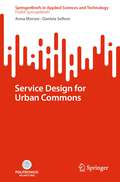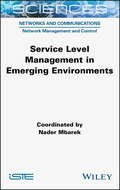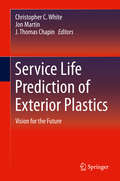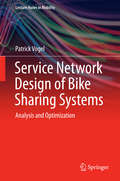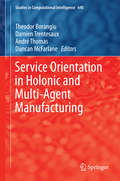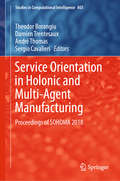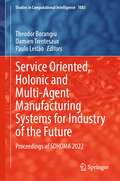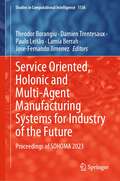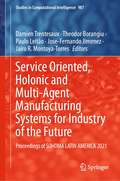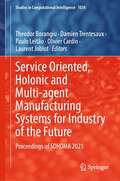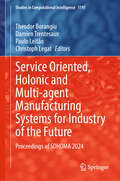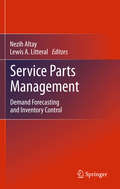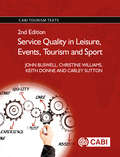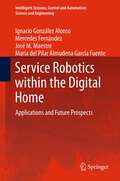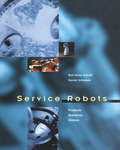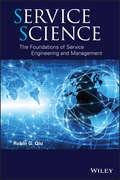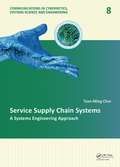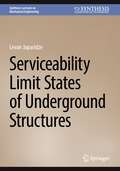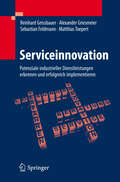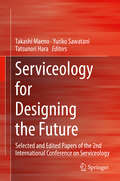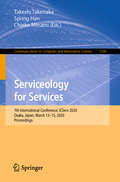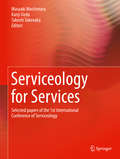- Table View
- List View
Service Design for Urban Commons (SpringerBriefs in Applied Sciences and Technology)
by Daniela Selloni Anna MeroniThis book explores the application of service design to urban commons. It originates from a project developed by the research group of POLIMI DESIS Lab of Politecnico di Milano, aimed at imagining the future of the Reggio Emilia Ducal Palace and its park - the Reggia di Rivalta. The peculiarity of the project lays in the idea that the design of a (public) space should be informed by the design of its services, because the development of specific activities actually builds a fundamental part of the identity of a place, conceiving both the tangible and intangible dimensions as part of a single creative process. The combination of a participatory process and the integration of spatial and service design led to infrastructuring a multi-stakeholder participatory action research of envisioning the future of a public good. This effort has been thus framed into a working methodology, specific tools and progressive outputs, which are defined as Service Master Planning (the process), and Service Master Plan (the product), allowing service design professionals to expand their knowledge and develop skills for a new field of application connected to urban planning.
Service Level Management in Emerging Environments
by Nader MbarekNetworks are now embedded in daily life thanks to smaller, faster, inexpensive components that are more powerful and increasingly connected. Parallel to this quantitative explosion of communication networks, technology has become more complex. This development comes with challenges related to management and control, and it has become necessary to manage the service level demands of the client to which the service provider commits. Different approaches to managing one or more service level components in different emerging environments are explored, such as: the Internet of Things, the Cloud, smart grids, e-health, mesh networking, D2D (Device to Device), smart cities and even green networking. This book therefore allows for a better understanding of the important challenges and issues relating to Quality of Service (QoS) management, security and mobility in these types of environment.
Service Life Prediction of Exterior Plastics
by Christopher C. White Jon Martin J. Thomas ChapinThis book defines the current state-of-the-art for predicting the lifetime of plastics exposed to weather and outlines the future research needed to advance this important field of study. Coverage includes progress in developing new science and test methods to determine how materials respond to weather exposure. This book is ideal for researchers and professionals working in the field of service life prediction. This book also: Examines numerous consensus standards that affect commercial products allowing readers to see the future of standards related to service life prediction Provides scientific foundation for latest commercially viable instruments Presents groundbreaking research including the blueprint of a new test method that will significantly shorten the service life prediction process time Covers two of the latest verified predictive models, which demonstrate realized-potential to transform the field
Service Network Design of Bike Sharing Systems
by Patrick VogelThis monograph presents a tactical planning approach for service network design in metropolitan areas. Designing the service network requires the suitable aggregation of demand data as well as the anticipation of operational relocation decisions. To this end, an integrated approach of data analysis and mathematical optimization is introduced. The book also includes a case study based on real-world data to demonstrate the benefit of the proposed service network design approach. The target audience comprises primarily research experts in the field of traffic engineering, but the book may also be beneficial for graduate students.
Service Orientation in Holonic and Multi-Agent Manufacturing
by Duncan Mcfarlane Theodor Borangiu André Thomas Damien TrentesauxThis volume gathers the peer reviewed papers which were presented at the 5th edition of the International Workshop "Service Orientation in Holonic and Multi-agent Man-ufacturing - SOHOMA'15" organized in November 5-6, 2015 by the Institute for Manufacturing (IfM) of the University of Cambridge, UK in collaboration with the CIMR Research Centre in Computer Integrated Manufacturing and Robotics of the University Politehnica of Bucharest, Romania, the LAMIH Laboratory of Industrial and Human Automation Control, Mechanical Engineering and Computer Science of the University of Valenciennes and Hainaut-Cambrésis, France and the CRAN Re-search Centre for Automatic Control, Nancy of the University of Lorraine, France. The book is structured in seven parts, each one grouping a number of chapters de-scribing research in actual domains of the digital transformation in manufacturing and trends in future manufacturing control: (1) Applications of Intelligent Products; (2) Advances in Control of Physical Internet and Interconnected Logistics; (3) Sustaina-bility Issues in Intelligent Manufacturing Systems; (4) Holonic and Multi-agent Sys-tem Design for Industry and Services; (5) Service Oriented Enterprise Management and Control; (6) Cloud and Computing-oriented Manufacturing; (7) Smart Grids and Wireless Sensor Networks. These seven evolution lines have in common concepts, methodologies and imple-menting solutions for the Digital Transformation of Manufacturing. The book offers an integrated vision on complexity, big data and virtualization in service- and compu-ting-oriented manufacturing, combining emergent information and communication technologies, control with distributed intelligence and MAS implementation for total
Service Orientation in Holonic and Multi-Agent Manufacturing: Proceedings Of Sohoma 2017 (Studies in Computational Intelligence #762)
by Theodor Borangiu André Thomas Damien Trentesaux Sergio CavalieriThis book gathers the peer-reviewed papers presented at the 8th edition of the International Workshop “Service Orientation in Holonic and Multi-Agent Manufacturing – SOHOMA’18” held at the University of Bergamo, Italy on June 11–12, 2018. The objective of the SOHOMA annual workshops is to foster innovation in smart and sustainable manufacturing and logistics systems by promoting new concepts, methods and solutions that use service orientation of agent-based control technologies with distributed intelligence.Reflecting the theme of SOHOMA’18: “Digital transformation of manufacturing with agent-based control and service orientation of Internet-scale platforms”, the research included focuses on how the digital transformation, as advocated by the “Industry 4.0”, “Industrial Internet of Things”, “Cyber-Physical Production Systems” and “Cloud Manufacturing” frameworks, improves the efficiency, agility and sustainability of manufacturing processes, products, and services, and how it relates to the interaction between the physical and informational worlds, which is implemented in the virtualization of products, processes and resources managed as services.
Service Oriented, Holonic and Multi-Agent Manufacturing Systems for Industry of the Future: Proceedings of SOHOMA 2020 (Studies in Computational Intelligence #952)
by Theodor Borangiu Damien Trentesaux Paulo Leitão Olivier Cardin Samir LamouriThe scientific theme of the book concerns “Manufacturing as a Service (MaaS)” which is developed in a layered cloud networked manufacturing perspective, from the shop floor resource sharing model to the virtual enterprise collaborative model, by distributing the cost of the manufacturing infrastructure - equipment, software, maintenance, networking - across all customers.MaaS is approached in terms of new models of service-oriented, knowledge-based manufacturing systems optimized and reality-aware, that deliver value to customer and manufacturer via Big data analytics, Internet of Things communications, Machine learning and Digital twins embedded in Cyber-Physical System frameworks. From product design to after-sales services, MaaS relies on the servitization of manufacturing operations such as: Design as a Service, Predict as a Service or Maintain as a service.The general scope of the book is to foster innovation in smart and sustainable manufacturing and logistics systems and in this context to promote concepts, methods and solutions for the digital transformation of manufacturing through service orientation in holonic and agent-based control with distributed intelligence.The book’s readership is comprised by researchers and engineers working in the manufacturing value chain area who develop and use digital control solutions in the ‘Industry of the Future’ vision. The book also addresses to master and Ph.D. students enrolled in Engineering Sciences programs.
Service Oriented, Holonic and Multi-Agent Manufacturing Systems for Industry of the Future: Proceedings of SOHOMA 2022 (Studies in Computational Intelligence Series #1083)
by Theodor Borangiu Damien Trentesaux Paulo Leitão<p>The scientific theme of the book is “Virtualisation – a multifaceted key enabler of Industry 4.0 from holonic to cloud manufacturing” which is addressed in the framework of cyber-physical system development.<p> <p>The book approaches cyber-physical systems for manufacturing with emergent digital technologies: Internet of Things, digital twins (based on the virtualization of production models embedded in the design, virtual commissioning, optimization and resilience of processes and fault tolerance of resources), big data, cloud control and computing, machine learning and cobots, that are applied in the book’s chapters to industry and service sectors such as manufacturing, energy, logistics, construction and health care.<p> <p>The novelty of this approach consists in interpreting and applying the characteristics of RAMI4.0—the reference architecture model of the Industry 4.0 framework—as combinations of virtualized cyber-physical system elements and IT components in life cycle value stream models.<p> <p>The general scope of the book is to foster innovation in smart and sustainable manufacturing and logistics systems and in this context to promote concepts, methods and solutions for the digital transformation of manufacturing through service orientation in holonic and agent-based control with distributed intelligence.<p>
Service Oriented, Holonic and Multi-Agent Manufacturing Systems for Industry of the Future: Proceedings of SOHOMA 2023 (Studies in Computational Intelligence #1136)
by Theodor Borangiu Damien Trentesaux Paulo Leitão Lamia Berrah Jose-Fernando JimenezThe scientific theme of the book is “Sustainability for the digital manufacturing era” which is focused on how the technological enablers of digital systems drive the sustainability for products, processes, manufacturing, and logistics systems in the industry of the future. The book’s chapters describe sustainability drivers specific to the technological advances that motivate, encourage, and engage the economic, social, and environmental aspects within intelligent manufacturing and logistics systems. The novelty of this approach consists in extending the economic sustainability of digital manufacturing with the ethical perspective at human social scale. The general scope of the book is to foster innovation in smart and sustainable manufacturing and logistics systems and in this context to promote concepts, methods, and solutions for the digital transformation of manufacturing through service orientation in holonic and agent-based control with distributed intelligence. The book’s readership is comprised of researchers and engineers working in the value chain of products and processes, who develop digital control solutions in the “Industry of the Future” vision. The book is also addressed to master’s and Ph.D. students enrolled in Engineering Sciences programs.
Service Oriented, Holonic and Multi-Agent Manufacturing Systems for Industry of the Future: Proceedings of SOHOMA LATIN AMERICA 2021 (Studies in Computational Intelligence #987)
by Theodor Borangiu Damien Trentesaux Paulo Leitão Jose-Fernando Jimenez Jairo R. Montoya-TorresThis book approaches its subject matter by promoting concepts, methods and solutions for the digital transformation of manufacturing through service orientation in holonic and agent-based control with distributed intelligence. The scientific theme of the book concerns “Manufacturing as a Service”, developed by virtualizing and encapsulating manufacturing resources, activities and controls into cloud networked services in an open perspective that spans models from shop floor resource allocation to enterprise infrastructure sharing. The papers included in the application space have a profound human dedication and aim at solving societal needs serving the partnership of the future—people and industry in the era of Society 5.0. The book’s readership includes researchers and engineers working in manufacturing, supply chains and logistics areas who innovate, develop and use digital control solutions and students enrolled in Engineering and Service Science programs.
Service Oriented, Holonic and Multi-agent Manufacturing Systems for Industry of the Future: Proceedings of SOHOMA 2021 (Studies in Computational Intelligence #1034)
by Theodor Borangiu Damien Trentesaux Paulo Leitão Olivier Cardin Laurent JoblotThis volume gathers the peer reviewed papers presented at the 11th edition of the International Workshop on Service-oriented, Holonic and Multi-Agent Manufacturing Systems for the Industry of the Future, SOHOMA’21, organized on 18-19 November, 2021 by the Arts et Métiers Institute of Technology of Cluny, France in collaboration with University Politehnica of Bucharest (the CIMR Research Centre in Computer Integrated Manufacturing and Robotics), Polytechnic University Hauts-de-France (the LAMIH Laboratory of Industrial and Human Automation Control, Mechanical Engineering and Computer Science) and Polytechnic Institute of Bragança (the CeDRI Research Centre in Digitalization and Intelligent Robotics).
Service Oriented, Holonic and Multi-agent Manufacturing Systems for Industry of the Future: Proceedings of SOHOMA 2024 (Studies in Computational Intelligence #1197)
by Theodor Borangiu Damien Trentesaux Paulo Leitão Christoph LegatThis book centres on methods and tools for data sharing in a secure way and on value-adding application of artificial intelligence (AI) in industrial production and logistics for the transformation to data-driven industry of the future. The scientific theme of the book is &“Industrial Artificial Intelligence in the Data-driven Industry of the Future: Models, Architectures, and Applications&” which is focused on exploring the intricacies of cross-enterprise data sharing and the strategic use of AI within manufacturing systems. An important analysis is offered to reveal the interconnections between research, regulation and standardization of artificial intelligence and digital twins in Industry 4.0 from an European perspective. The novelty of this approach consists in analysing the ethical risks associated with the use of generative AI techniques in industrial systems and their short-, medium- and long-term impact on performance and human well-being protection. The general scope of the book is to foster innovation in smart and sustainable manufacturing and logistics systems and in this context to promote concepts, methods and solutions for the digital transformation of manufacturing through service orientation in holonic and agent-based control with distributed intelligence. The book&’s readership is comprised by researchers and engineers working in the value chain of products and processes including material sourcing, production, consumption and disposal/recycling processes, who develop digital control solutions in the &“Industry of the Future&” vision. The book also addresses to master and Ph.D. students enrolled in engineering sciences programs.
Service Parts Management
by Lewis A. Litteral Nezih AltayWith the pressure of time-based competition increasing, and customers demanding faster service, availability of service parts becomes a critical component of manufacturing and servicing operations. Service Parts Management first focuses on intermittent demand forecasting and then on the management of service parts inventories. It guides researchers and practitioners in finding better management solutions to their problems and is both an excellent reference for key concepts and a leading resource for further research. Demand forecasting techniques are presented for parametric and nonparametric approaches, and multi echelon cases and inventory pooling are also considered. Inventory control is examined in the continuous and periodic review cases, while the following are all examined in the context of forecasting: * error measures, * distributional assumptions, and * decision trees. Service Parts Management provides the reader with an overview and a detailed treatment of the current state of the research available on the forecasting and inventory management of items with intermittent demand. It is a comprehensive review of service parts management and provides a starting point for researchers, postgraduate students, and anyone interested in forecasting or managing inventory.
Service Quality in Leisure and Tourism
by Christine Williams John Buswell Keith Donne Carley SuttonService quality is at the forefront of how the leisure, events, tourism and sport (LETS) sectors operate. An important consideration for any business, and therefore any student of the subject, this new edition of a successful textbook addresses the key points and principles of managing service quality across the industry sector. Fully updated and enhanced, it: - Covers areas such as the experience economy, capacity management and service culture, as well as methods for measuring quality and satisfaction. - Includes numerous case studies to help students apply classroom-based theory to practice. - Is packed with student-friendly pedagogy and full colour illustrations throughout to enhance the learning experience. Considering the underpinning theory of service quality, this book informs the reader of the practical application of service quality management tools and techniques in an industry with distinctive features and challenges. An invaluable read for students within the LETS sectors, it also provides a useful refresher for practitioners working in the industry.
Service Robotics within the Digital Home
by Ignacio González Alonso Mercedes Fernández José M. Maestre María del García FuenteThis book provides the reader with a clear and precise description of robotics and other systems for home automation currently on the market, and discusses their interoperability and perspectives for the near future. It shows the different standards and the development platforms used by the main service robots in an international environment. This volume provides a scientific basis for the user who is looking for the best option to suit his or her needs from the available alternatives to integrate modern technology in the digital home.
Service Robots
by Rolf Dieter Schraft Gernot SchmiererThe copious photographs in this book lavishly illustrate the current and future applications for robots in a wide scope of fields such as entertainment, medicine, space exploration, underwater navigation, and many more. Everyone from professional roboticists to amateur robot and technology enthusiasts will find this book fascinating.
Service Science: The Foundations of Service Engineering and Management
by Robin G. Qiul natures Computational thinking and system modeling such as abstraction, digitalization, holistic perspectives, and analytics Plentiful examples of service organizations such as automobile after-sale services, global project management networks, and express delivery services An interdisciplinary emphasis that includes integrated approaches from the fields of mathematics, engineering, industrial engineering, business, operations research, and management science A detailed analysis of the key concepts and body of knowledge for readers to master the foundations of service management Service Science: The Foundations of Service Engineering and Management is an ideal reference for practitioners in the contemporary service engineering and management field as well as researchers in applied mathematics, statistics, business/management science, operations research, industrial engineering, and economics. The book is also appropriate as a text for upper-undergraduate and graduate-level courses in industrial engineering, operations research, and management science as well as MBA students studying service management.
Service Supply Chain Systems: A Systems Engineering Approach (Communications in Cybernetics, Systems Science and Engineering)
by Tsan-Ming ChoiSupply chain management is a well-developed area. The traditional supply chains are dynamic systems which include the forward and reverse flows of physical products and the related information and fund. However, a service supply chain is different because the real "product" may take the form of a "service" which implies that many traditionally cruc
Service Systems Engineering and Management (Operations Research Series)
by A. Ravi Ravindran Paul M. Griffin Vittaldas V. PrabhuThis new textbook will provide state-of-the-art models, concepts and solution methods important in the design, control, operation, and management of service systems. It will cover supply chain management, warehouse & distribution, financial engineering, revenue management in airlines, retail engineering, health systems, and financial services, etc... The textbook is for the engineering market, emphasizing the application of operations research models to optimally design and manage service systems. Currently, no such textbook exists in the market. Service management textbooks tend to be focused on the business school audience and therefore treat the topic overly, or exclusively, qualitatively. Many do not include health systems, retail industries, or financial sectors in their coverage.
Service Systems Management and Engineering: Creating Strategic Differentiation and Operational Excellence
by Ching M. ChangThe ultimate instructional guide to achieving success in the service sector Already responsible for employing the bulk of the U.S. workforce, service-providing industries continue to increase their economic dominance. Because of this fact, these companies are looking for talented new service systems engineers to take on strategic and operational challenges. This instructional guide supplies essential tools for career seekers in the service field, including techniques on how to apply scientific, engineering, and business management principles effectively to integrate technology into the workplace. This book provides: Broad-based concepts, skills, and capabilities in twelve categories, which form the "Three-Decker Leadership Architecture," including creative thinking and innovations in services, knowledge management, and globalization Materials supplemented and enhanced by a large number of case studies and examples Skills for successful service engineering and management to create strategic differentiation and operational excellence for service organizations Focused training on becoming a systems engineer, a critically needed position that, according to a 2009 Moneyline article on the best jobs in America, ranks at the top of the list Service Systems Management and Engineering is not only a valuable addition to a college classroom, but also an extremely handy reference for industry leaders looking to explore the possibilities presented by the expanding service economy, allowing them to better target strategies for greater achievement. The book was recently awarded the 2011 Best Book Award by the International Association for Management of Technology (IAMOT.)
Serviceability Limit States of Underground Structures (Synthesis Lectures on Mechanical Engineering)
by Levan JaparidzeThe main topic of this book is the calculation of underground structures at the limit states of serviceability. It considers the main schemes typical for underground structures for various purposes, gives the corresponding mathematical models describing the main geo-mechanical and technological factors in the construction and operation of extended excavations. Generalized criteria are proposed for making a technically and economically justified solution of the problem of determining the optimal forms and sizes of workings, bearing capacity, type of support and its erection, depending on the structural features of the rock mass, the primary stress fields of gravitational, tectonic, seismic acting in it. and technological origins, operational requirements for extended excavations. The corresponding algorithms, block diagrams and specific numerical examples of calculations are given. In most of the existing calculation methods the structure is considered in the elastic stage, the strength limit of the bearing capacity is considered as the moment when the maximum internal stresses reach the corresponding design resistances of the material. If it is legitimate to use this criterion in certain cases of calculation of statically determinable structures operating in the given loading mode, then in cases where the support operates in the mode of mutually influencing deformation together with the rock mass, it leads to a significant waste of material.
Serviceinnovation
by Matthias Toepert Alexander Griesmeier Reinhard Geissbauer Sebastian FeldmannAuch Unternehmen, die sich hauptsächlich auf die technische Entwicklung und Herstellung ihrer Produkte konzentrieren, müssen neue Kunden gewinnen und langfristig an sich binden. Das Buch bietet eine Anleitung für den Weg hin zum industriellen Dienstleistungsunternehmen: An Beispielen führender Industriebetriebe (Automotive, Maschinenbau, Informationstechnologie) wird erläutert, welche Konzepte nachhaltig zum Erfolg führen. Mit Tools zur Einschätzung der eigenen Serviceleistung und -reife, Schritt-für-Schritt-Anleitungen und Handlungsempfehlungen.
Serviceology for Designing the Future: Selected and Edited Papers of the 2nd International Conference on Serviceology
by Yuriko Sawatani Takashi Maeno Tatsunori HaraThis book provides a useful overall guide to the state of the art in theory and practice of services. It can also serve as a reference book for researchers in various fields, including engineering, marketing, economics, and other disciplines. Advanced works presented here were selected from the proceedings of the Second International Conference on Serviceology (ICServ2014), held September 14–16, 2014. This book helps readers to understand serviceology, which tackles with a broad range of services, the globalization of the economy and also enhances the quality of life of local residents.
Serviceology for Services: 7th International Conference, ICServ 2020, Osaka, Japan, March 13–15, 2020, Proceedings (Communications in Computer and Information Science #1189)
by Takeshi Takenaka Spring Han Chieko MinamiThis book constitutes the refereed proceedings of the 7th International Conference on Serviceology for Services, held in Osaka, Japan, in March 2020.The 16 full papers and 3 short papers presented in this volume were carefully reviewed and selected from 58 submissions. The papers are organized around the following topics: hospitality management; service innovation and employee engagement; service marketing and consumer behavior; customer experience and service design; service engineering and implementation.
Serviceology for Services: Selected papers of the 1st International Conference of Serviceology (Communications In Computer And Information Science Ser. #1189)
by Masaaki Mochimaru Kanji Ueda Takeshi TakenakaServices are key activities in the globalization of the economy and also underlie the quality of life of local residents. The advanced work presented in this book was selected from the proceedings of the First International Conference on Serviceology (ICServ2013), held October 16–18, 2013 in Tokyo. This book provides a useful overall guide to the state of the art in theory and practice of services for researchers in various fields, including engineering, marketing, economics, and others. This work also facilitates the scientific systematization of services and promotes technological developments for solutions of industrial issues.
